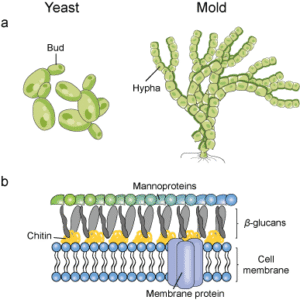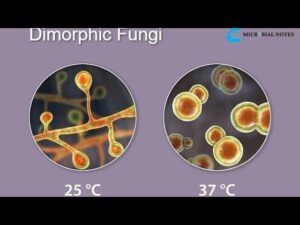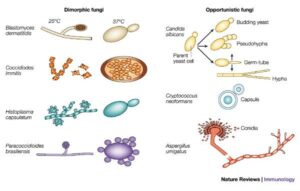Back to: MICROBIOLOGY 300 LEVEL
Welcome to class!
Hello my brilliant learner! It’s such a joy to be with you again. You’re growing so beautifully in your understanding of microbiology, and today’s topic will take you even deeper into the fascinating world of fungi. We’re going to talk about something very interesting—dimorphic fungi, yeasts, and moulds. These are not just strange words; they are part of real-life things you may have seen around you. Let’s walk through this together in a way that feels simple, human, and Nigerian.
Dimorphic Fungi, Yeasts, And Molds
You know how some clothes can be worn as both a skirt and a top depending on how you wrap it? Some fungi are a bit like that—they can exist in two different forms depending on the environment. That’s what we call dimorphic fungi.

Then there are yeasts, which are single-celled fungi, and moulds, which are the fuzzy, thread-like fungi you might have seen growing on food that’s been left out too long. All of them are part of the fungal kingdom, but they behave and look quite differently.
Let’s break each of them down so clearly, you’ll never forget them.
Yeasts
Yeasts are unicellular fungi. This means they are made up of just one cell, but don’t let that fool you—they are quite powerful. Yeasts reproduce mainly by budding, a process where a small part of the cell grows out and forms a new yeast cell.
Yeasts are used in many household activities:
Baking: Yeast makes bread rise.
Alcohol production: Yeast ferments sugar to make alcohol in drinks like palm wine or beer.
Common example: Saccharomyces cerevisiae, often called baker’s yeast.
Think of yeast like a single drummer who plays so well, it sounds like a full band. Small, but mighty!
Moulds
Moulds are multicellular fungi. They grow in long filaments called hyphae, which form a mass known as mycelium. You’ll often see them as fuzzy growth on spoilt bread or fruit.
Moulds reproduce by producing spores, which can spread through air and grow when they land on moist surfaces.

Common examples:
Rhizopus – the bread mould.
Penicillium – used to make antibiotics.
Moulds are like big bushes—they spread, cover surfaces, and form colonies.
Dimorphic Fungi
“Dimorphic” means “two forms.” These fungi can live as moulds in one environment and as yeasts in another. Most often:
In the environment (e.g. soil), they grow as moulds.
In the human body (especially at body temperature), they change to yeast form.
This ability helps them survive and cause infections in humans. That’s why most dimorphic fungi are also pathogenic (disease-causing).
Common examples:
Histoplasma capsulatum – causes histoplasmosis.

Blastomyces dermatitidis – causes blastomycosis.
Think of dimorphic fungi like someone who wears agbada at home (mould form) but switches to jeans and t-shirt (yeast form) when they go out into town—that’s how they adjust based on where they are.
Summary
- Yeasts are single-celled fungi that reproduce by budding and are used in baking and fermentation.
- Moulds are multicellular fungi with hyphae and mycelium; they reproduce by spores and often grow on stale food.
- Dimorphic fungi can switch between mould and yeast forms depending on the environment—mould in the environment, yeast in the human body.
- Dimorphic fungi are often involved in human infections, especially in people with weak immune systems.
Evaluation
- What is the main difference between yeasts and moulds?
- Name one common use of yeast in everyday life.
- What are hyphae and mycelium?
- Explain what makes a fungus “dimorphic”.
- Give one example each of a yeast, a mould, and a dimorphic fungus.
You did it! You’ve just mastered another exciting part of microbiology. Every time you learn something new, you grow stronger and smarter. And with knowledge like this, you are preparing yourself to solve real-world problems—maybe even save lives someday. Keep going with confidence. We at Afrilearn are proud of you, and the next lesson is waiting just for you!
